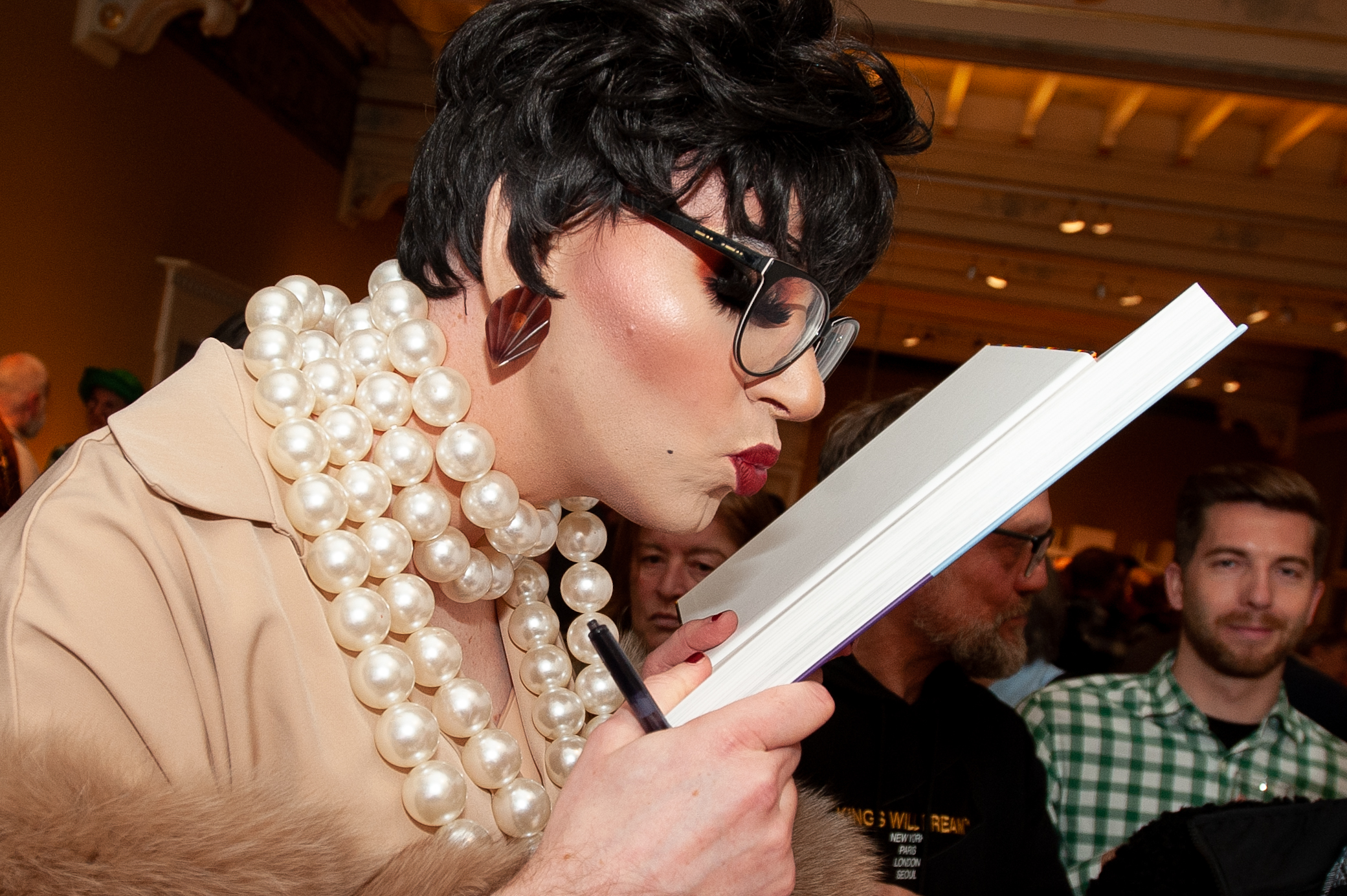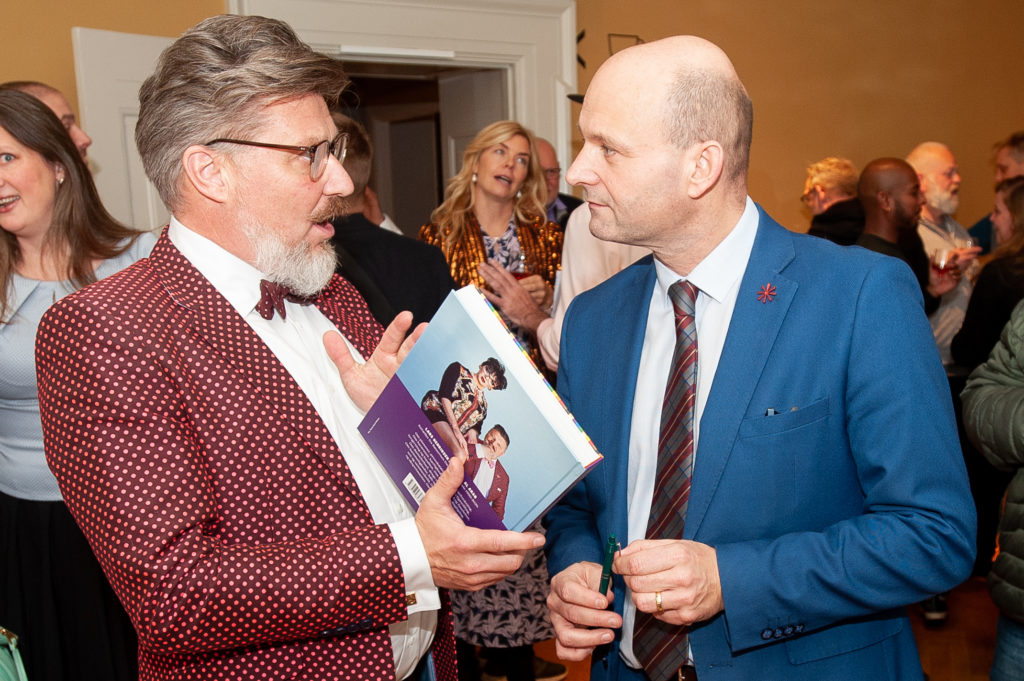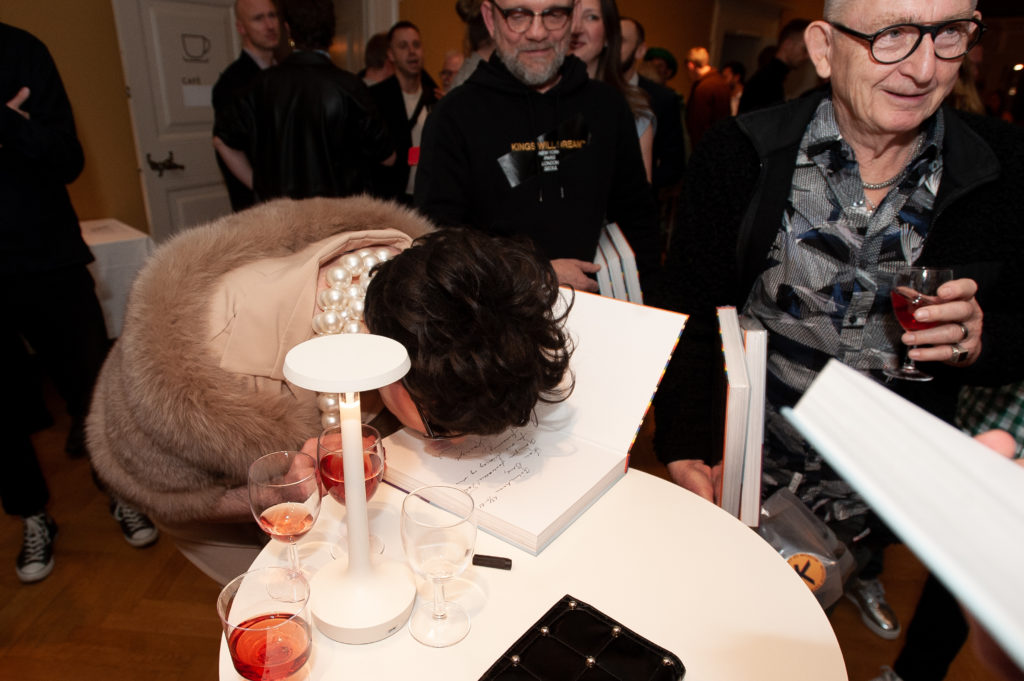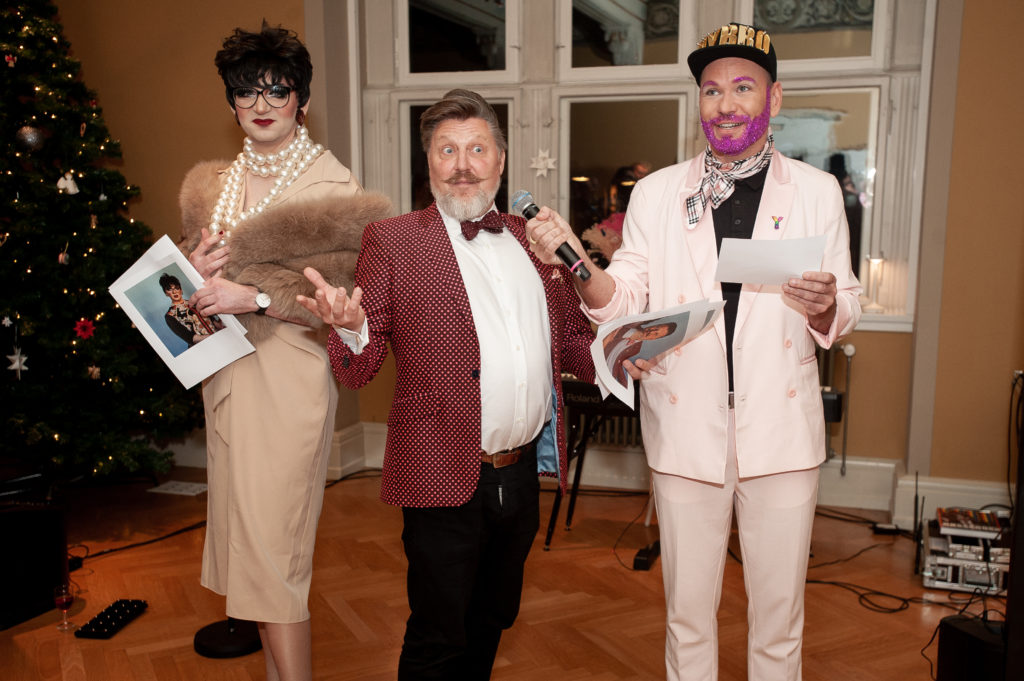
Sustaining history with stories: A chat with Lars Henriksen and Chantal al-Arab
By Nicola Pettinger
Photos by Renato Manzionna
It’s a dark, dull, windy, and cold afternoon as I knock on the door of the bright and gleaming new Copenhagen Pride office, ready to speak to Lars Henriksen and Chantal al-Arab about their book – Bøssernes Danmarkshistorie 1900-2020. Spirits lift with the wonderful rainbows, hot tea, and two incredibly engaging and interesting people to speak with. We talk about the theme of this issue which is “sustainability” – and what is more important than making sure the fabric of history can be woven sustainably into our present and future? So, here goes…
Lars and Chantal’s book Bøssernes Danmarkshistorie 1800-2020 can be purchased in bookstores and online via their publisher, Forlaget 28B.
Hello both of you! And thank you so much for taking the time to speak with me. This is truly a beautiful book, and no doubt you’re incredibly proud. Perhaps you could start by telling me a little about it?
Chantal: Yes of course. This is a chronological history of the lives of gay men in Denmark from 1900 until 2020. We started in 1900 because there is already a two-volume thesis that covers the period 1660-1912. No one has picked up the torch since, so we decided we would.
Lars: We contemplated whether it should be a full LGBTI+ history – but in the end we realized that as gay men, we are experienced with our own history, environment, and community.
Chantal: Exactly, although everyone in the LGBTI+ community has faced discrimination, we all have unique stories, and it would lessen the individual stories if we tried to fit them all in. All the histories are different, so… we focused on what we know. We realized that when looking at sources, perhaps we can pick up on the camp or the faggotry in the source because of our lived experiences. Perhaps someone else wouldn’t.
“We realized that when looking at sources, perhaps we can pick up on the camp or the faggotry in the source because of our lived experiences.”
Absolutely – and perhaps you could also speak about the title you have chosen? I wonder if I miss anything from the context when translating into English?
Chantal: Well, yes, like it says on the cover, some people do call this a history book. But we are very clear in the preface – this is about stories. History consists of a million small stories, and we have tried to capture that. We are not putting a top-down story onto people – that can be problematic for a traditionally marginalized group. It is so important to have the smaller stories, to find and follow the lives of our heroes and share their lived experiences.
Lars: Yes – we had a lot of discussion about the title. We had wanted to call it “Gay Stories” and in the end we crafted the title “Lars and Chantal tell from the stories of Danish gays” – story and history being the same word in Danish, wherefore we were able to play on the double entendre – and then in the preface we explain more about that.
Chantal: Also, let’s think about this word “Bøsse” [Danish word for gay man, ed.]. After learning about the Gay Liberation Front, I am so proud to use that word, to see myself as an extension of their work, those who took the word on themselves and reclaimed it.
Thinking of sustainability, then, are these stories ever-changing?
Lars: Oh, I’m absolutely sure of that! The next person could write their own book, including their own stories, and it would be completely different.
Chantal: I was jokingly saying to Lars that I hope some people get so upset by our choices that they want to do better and really go out and do their own research! When you find these queer people in history books it says nothing about that aspect of their lives. We’ve made them visible.
Lars: Look here – I’ll show you – in the book we’ve made their names pink, so they are truly visible. So, if this sells it will show that something LGBTI+ has value outside of the community. And that our community wants to know about our own history – the critics have already spoken about what’s not included, and it’s really nice to see.
(Laughing) Amazing – well, that’s for another interview!
Chantal: I just hope that we see much more history written from the view of historically marginalized groups. It’s important for the mainstream to discover that the history they are presented with is actually a curated version; a lot of people are written out to make ends meet.
Lars: And also, how our society – Danish society – has reacted to different people through history. How we treat “otherness”. It’s also the activist perspective to the book, that as LGBTI+ people in general we don’t see ourselves reflected in history, and the traditions we celebrate. This book is at least a starting point to get to know their own story and where they come from.
Chantal: We’ve always been here – there’s no getting rid of us!
So, we can see the narrative from history in how we sustain our story today?
Lars: If we are to survive then we need our roots. This allows us to stand firm in a storm.
Chantal: There is a need for a sense of LGBTI+ community, and for that we need to be able to imagine ourselves as one. Change doesn’t come out of nothing, and we are not automatically marching toward the light. Danes are good at telling themselves that they are from a liberal and accepting country – but when we go into the sources, we see it’s not at all like this! The rights we have today are the result of the work of activists, a few very stubborn politicians, a few doctors and scientists who were considered radicals in their age. We got here not because the mainstream wanted to give us rights – and that means we can’t take for granted that we will have more rights tomorrow.
Lars: (Interjecting) I just want to say that we are not always marching toward the same light. One of the things we talk about in the book is the passing of the Law on Registered Partnership in 1989, which is generally considered to be a huge step forward for the LGBTI+ community. But there were also groups at the time who opposed the proposal because it didn’t allow for family rights, such as adopting common children.


Going back to that – the theme of the issue is sustainability. You’ve looked through time at rights that have come. What kind of position of sustainability of those rights do you see at the moment?
Chantal: If we speak about sustainability, to me that includes the ability to imagine the future. We have the ability to imagine what kind of world we want. The beauty of the human mind is that we have the gift to imagine a better world. And when it comes to sustainability – social, economic, climate, all these types of sustainability, we need to imagine what kind of world we want to live in and march there.
Lars: There has been a lot of internal strife in our community over time which has blocked change. If we could lift each other up and learn that from history, sustain each other as a community, then there is no end to what we can do in our country and beyond.
There is a lot of responsibility when telling the story of a whole community. How has it been for you? You’re smiling at each other as I ask this – tell me more…
Chantal: We talked about it! Ongoing discussions about how to do this: what do we omit, include, why? Even though the language is at times camp, we’ve been quite mindful that this is written from the queer perspective and of the stories that we need to include so we feel like we are delivering a holistic view on the history of gay men in Denmark.
Lars: That’s not to say we haven’t been scared on the way, thinking that people may say “who are they to claim our story?” We were a little anxious when the book first came out to see how it would be received. But now we see that it’s almost as though people have wanted this for so long that they are excited, it’s not about us – it’s about the history being told.
In terms of your experience drawing all of that together – what impact did it have on you hearing those stories?
Chantal: Oh, life changing.
Lars: We find it worth our while to collect this material, because at a certain point those resources will be gone. We still do interviews now, and we write them all out and put them into archives so that the next people who in 50 years might like to write something have got the source materials.
Chantal: We had so much rich information. If you look at the manuscript we handed in, around 100 pages have been cut out. So, it really is a curation, the greatest hits of Danish gay men.
That’s a really lovely way to describe it, and perfect for my next question – perhaps you could tell me about what is most important personally for you? I guess you may have different answers…
Lars: I wouldn’t say one thing, but there is a particular feature – “if you want to learn more, this is where you can start”. We’ve put in a number of what you can call “menu boxes” (opens book to demonstrate). This one here – gays in literature. So, if you want to start then this is a suggestion of the 25 most significant gay novels over the century – start here! We’ve got the same thing for films, for people who were in the arts, we’ve got it for actors, we’ve done it for people in power. If you want to just know a little bit, this is where you can start.
Chantal: I would say a great feature of the book that people could enjoy is the many images. People can see into the eyes of gays in the past. They can all of a sudden put a face on people and say “oh! This is what he looked like!”. This may be a bit gay – but also the fact that it looks fabulous! This is a book you can have on your coffee table…
(Interjecting) – that’s exactly what I was going to say!
…And say, what a beautiful book! Pick it up and look through it. Of course, what’s on the page, the content, is most important, but it’s also visually appealing.
Do you feel then that this helps with keeping the stories alive?
Chantal: I feel very close to a lot of these people, even though I have never met them. A lot of them have passed – but I started recognizing names and I got this feeling of their community and my community being related. One of the doctors in this picture was the first doctor to write about AIDS in a gay magazine of the time. I found his obituary later, and I remember I was sad when I read it. I felt like I’d lost a friend because I’d “met” him so many times in images and text, that I felt like I knew him.
How incredible. Let me just pick up on this one – you had this experience where you felt very close to the people through your communities. Can you tell me about your personal journey as you were writing? Things that have stuck with you on an emotional level?
Lars: This project has bubbled in me for a number of years, and fortunately I’ve collected a lot of things from second-hand bookshops over time. We had much of the material and now one collected set of stories – and that for me is very emotional. To see me and my people in print, that there is somewhere I can point to on my shelf.
We’ve covered so many questions. Any stand-out learnings, aha moments? Anything you hadn’t come across before?
Lars: We often judge history through contemporary glasses – it’s not always been like we see it now.
Thank you so much! This has been an incredibly rich and educational conversation.




